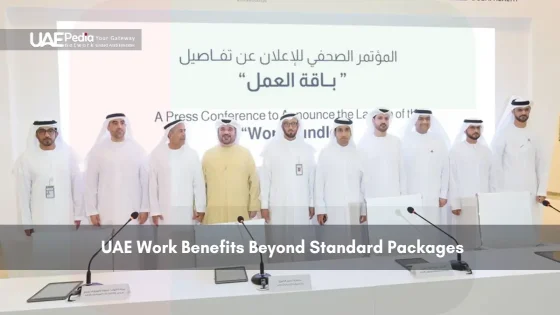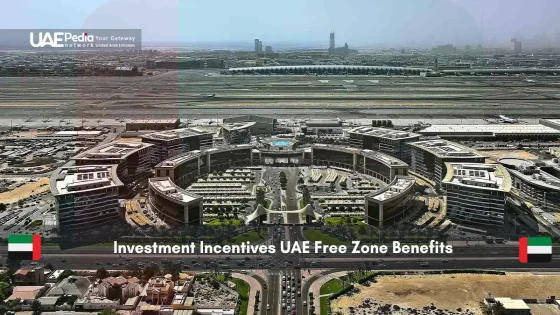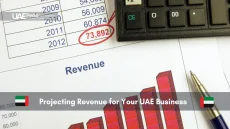Most companies know the basics: 30 days paid leave, health coverage, gratuity payments. But here’s what rarely makes the brochure—employers skimping on mandatory benefits risk fines heavier than a summer sandstorm. Meanwhile, top talent flocks to firms offering extras like relocation packages and private pensions.
This isn’t just about compliance. It’s about crafting packages that honor both Emirati labor laws and the diverse needs of a workforce spanning 200 nationalities. We’ll unpack everything from maternity leave entitlements (60 days: 45 days at full pay and 15 days at half pay) to the math behind end-of-service bonuses.
Whether you’re hiring in Abu Dhabi’s tech hubs or Dubai’s trading floors, our comprehensive guide to UAE employee benefits blends legal must-knows with pro tips. Discover why some companies add “Ramadan flexibility” to contracts and how minimum wage structures shift based on education levels.
You’ll walk away knowing:
- How to calculate gratuity for employees exiting after 3 vs. 10 years
- Overtime pay rates: 125% of regular pay for hours beyond standard working hours; 150% for work between 10 PM and 4 AM; 150% plus a compensatory day off for work on public holidays.
- Why health insurance is now mandatory across all Emirates for private sector employees and domestic workers
Comprehensive Overview of UAE Employee Benefits in 2025
Imagine employee benefits as a desert highway—clear rules guide the journey, but unexpected turns demand smart navigation. Let’s map the essentials that keep both teams and employers cruising smoothly.
Updated Leave Entitlements Under UAE Labour Law 2025
Employees are entitled to 30 calendar days of annual leave after completing one year of service. For those with less than one year, leave is calculated at two working days per month—like a starter pack for work-life balance. Sick leave entitlement: First 15 days at full pay, next 30 days at half pay, followed by 45 days of unpaid leave if necessary.. Smart companies track this through automated systems to avoid messy calculations.
| Leave Type | Paid Days | Key Rules |
|---|---|---|
| Annual | 30 | Starts at 3 months |
| Sick | 45 total | Split payment tiers |
| Public Holidays | 13-15/year | Varies by public holiday pay rules |
Under the 2025 UAE Labour Law, female employees are entitled to 60 days of maternity leave, comprising 45 days at full pay and 15 days at half pay. This entitlement applies regardless of the employee’s length of service, promoting inclusivity and support for working mothers. Ref.: “UAE Labour Law 2025: New Rules for Pregnant Employees.” [!]
Calculating End-of-Service Gratuity in 2025
End-of-service gratuity is calculated as follows: For the first five years of service:
- 21 days’ basic salary per year.
- For each additional year beyond five: 30 days’ basic salary per year.
One catch: incomplete years get prorated. A 4.5-year employee? That’s (4×21) + (0.5×21) = 94.5 days’ pay. This golden handshake keeps top performers around for the long haul.
Free zones like DIFC tweak these rules slightly—always check local codes. Clear policies prevent “gratuity shock” during exits and build trust across 200+ nationalities.
End-of-service gratuity in the UAE is calculated based on the employee’s basic salary: 21 days’ salary for each of the first five years of service, and 30 days’ salary for each additional year. The total gratuity should not exceed two years’ worth of the employee’s basic salary. Ref.: “End of service benefits for workers in the private sector.” [!]
Understanding the Legal Framework for Employee Benefits in the UAE
Think of labor regulations as the steel framework beneath Dubai’s glittering towers—invisible yet essential. Every company’s benefits package rests on this legal bedrock, where non-compliance risks more than fines—it fractures trust.
Emirati employees in the private sector are subject to a pension contribution scheme totaling 26% of the contribution account salary: 11% by the employee and 15% by the employer. For salaries under AED 20,000, the government contributes 2.5% on behalf of the employer to encourage the hiring of UAE nationals. Ref.: “Monthly Contribution Employer Guideline – mohre.gov.ae.” [!]
Legal Foundations for Employee Benefits in the UAE
National law requires three pillars: health coverage, pension plans, and severance pay. As of January 1, 2025, all private sector employers across the UAE are required to provide health insurance coverage for their employees, including domestic workers. Pension contributions for Emirati employees in the private sector are set at 26% of the contribution account salary: 11% by the employee, 15% by the employer, with the government covering 2.5% for salaries under AED 20,000.
| Benefit | Dubai | Abu Dhabi |
|---|---|---|
| Health Insurance | Full employer coverage | Shared costs for salaries >AED 4k |
| Pension Contributions | 5% employer + 5% employee | 15% employer (public sector) |
| Severance Pay | 21 days/year first 5 years | Same base + sector bonuses |
Industry-Specific Compliance and Regulations
Construction firms face stricter safety nets—think housing allowances and heat stress protocols. Tech startups? Many leverage free zone flexibility to offer stock options alongside legal minimums. A 2022 case saw a hospitality group fined AED 500k for skipping Emiratization quotas, proving regulators mean business.
Smart employers treat labor codes like software updates—install patches regularly. When Dubai expanded parental leave in 2023, agile companies adapted policies within weeks. Compliance isn’t paperwork—it’s your shield against reputational sandstorms.
Key Employee Benefits in the UAE
Let’s crack open two pillars that shape career decisions here: exit payouts and medical coverage. These aren’t just numbers—they’re loyalty builders and life rafts.
While the UAE mandates health insurance coverage for all private sector employees, the cost-sharing structure varies by Emirate. In Abu Dhabi, employers cover 80% of the insurance cost for employees earning over AED 4,000, whereas in Dubai, employers are required to provide full coverage. Employers must navigate these regional differences to ensure compliance. Ref.: “The Basic Health Insurance Scheme | Awareness and Guidance | Media …” [!]
End-of-Service Gratuity and Pension Schemes
That farewell paycheck? It’s math with heart. For each full year served:
- Years 1-5: 21 days’ basic salary
- Year 6+: 30 days’ basic salary
A 7-year veteran earns (5×21) + (2×30) = 165 days’ pay. Emirati employees contribute 11% of their salary to pensions, with employers contributing 15%, and the government covering 2.5% for salaries under AED 20,000., while expats receive lump-sum gratuity. One tech firm saw 23% lower turnover after clarifying these calculations in offer letters.
Health Insurance Mandates and Variations
Medical coverage here splits like desert oases—Dubai demands full employer funding, Abu Dhabi shares costs for salaries over AED 4,000. Check this breakdown:
| Emirate | Coverage Rule | Employer Cost |
|---|---|---|
| Dubai | Full basic plan | 100% |
| Abu Dhabi | Salary >AED 4k | 80% company |
Dental? Vision? Those extras separate standard packages from standout ones. A recent survey found 68% of candidates prioritize health coverage over salary bumps under AED 300k. Smart move: bundle insurance tiers with performance milestones.
Supplemental Perks to Enhance Employee Benefits Packages
Picture your team’s benefits as a toolkit—mandatory items form the base, but supplemental perks are the specialized gadgets that solve modern workplace puzzles. While compliance keeps the lights on, creative extras spark loyalty and innovation.
Implementing Flexible Work and Remote Policies
Hybrid schedules aren’t just trendy—they’re talent magnets. A 2023 survey found 73% of professionals prioritize flexible working hours over salary bumps under AED 200k. Consider:
- Core collaboration days in-office
- Remote Fridays for focused tasks
- Time zone overlap hours for global teams
One tech startup reduced turnover by 40% after introducing “Summer Fridays” with half-day remote work. As one HR director shared:
“Flexibility says ‘we trust you’ louder than any handbook.”
Strategic Incentives to Attract and Retain Talent
Beyond ping-pong tables, today’s game-changers include:
- Relocation concierge services (think visa help + neighborhood tours)
- Quarterly wellness stipends for gyms or meditation apps
- Skill-building budgets tied to promotion tracks
Multinationals like a Dubai-based fintech firm blend global standards with local flair—offering Ramadan-adjusted deadlines and Eid bonus trips. Customization matters: a logistics company saw 31% faster hiring after adding school fee support for parent employees.
These strategies aren’t just nice-to-haves. They’re the secret sauce that turns job listings into career destinations. When your package reflects both business goals and team needs, you don’t just fill roles—you build communities.
Building a Competitive Employer Brand Through Benefits
Imagine your company’s reputation as a talent magnet—where thoughtful perks pull in top performers like iron filings. A 2023 Mercer study found 89% of professionals prioritize tailored packages over generic offerings. This isn’t just HR fluff—it’s the secret to standing out in crowded markets.
Tailoring Benefits Programs for Employee Retention
Smart companies treat benefits like custom suits—cut to fit individual needs. A Dubai logistics firm slashed turnover by 27% after adding school fee support and pet-friendly offices. Why? They addressed two core needs: family stability and personal lifestyle.
| Benefit Type | Impact on Retention | Employee Preference |
|---|---|---|
| Flexible childcare | 34% lower attrition | Parents: 82% priority |
| Skill-building budgets | 41% engagement boost | Under-35s: 76% |
| Hybrid work options | 29% longer tenure | All groups: 68% |
One tech CEO shared: “Our ‘choose-your-perk’ system reduced hiring costs by 19%—candidates self-select into our culture.” This approach mirrors global trends while respecting local preferences, like offering Ramadan-adjusted schedules.
Regular pulse surveys keep offerings fresh. A recent case saw a retail chain revamp its parental leave policy after 63% of staff requested extended family care options. The result? A 22% spike in internal referrals within six months.
Investing in personalized support pays dividends. Teams with aligned benefits show 31% higher productivity—proof that when companies listen, everyone wins.
Leveraging HR Technology and Data for Benefits Optimization
Welcome to the cockpit of modern HR management—where algorithms replace spreadsheets and real-time dashboards outpace guesswork. Tech-driven solutions now handle everything from tracking hours to tailoring services, freeing teams to focus on strategy over paperwork.
Streamlining Benefits Administration Through Automation
Gone are the days of manual leave balances and misfiled claims. Platforms like BambooHR slash errors by 78% while processing requests in minutes, not days. Here’s how automation transforms three core areas:
| Process | Manual Method | Tech Solution |
|---|---|---|
| Payroll | 12 hours monthly | 23-minute sync |
| Leave Tracking | Spreadsheet errors | Real-time dashboards |
| Compliance Updates | Reactive fixes | AI alerts |
One logistics firm reduced payroll disputes by 91% after switching to Workday. The secret? Automated compliance checks that flag discrepancies before payday. As one HR director noted:
“Our platform’s geo-specific rules engine handles seven Emirates’ regulations effortlessly—like having a legal co-pilot.”
Evaluating ROI and Adapting Benefit Offerings
Data doesn’t lie. Real-time analytics reveal which perks employees actually use—not just what looks good in brochures. Consider these insights from Namely’s 2023 report:
- Teams using predictive analytics adjust packages 3x faster
- 87% of staff prefer benefits tied to usage patterns
- ROI tracking cuts unnecessary costs by 34% annually
Smart companies now tweak offerings quarterly. A Dubai-based startup boosted retention 29% after data showed remote work Fridays mattered more than gym memberships. The lesson? Let employee behavior guide your next move.
Ready to upgrade? Start with bite-sized pilots—automate one process this quarter. Tech isn’t the future; it’s the now. And those who adapt? They’re already miles ahead.
Current Trends Influencing Employee Benefits in the UAE
Eight in ten working-age residents actively participate in the labor force—a staggering 82.6% engagement rate that’s reshaping how companies structure support systems. This surge isn’t just about numbers—it’s a cultural shift where 63% of professionals now prioritize tailored perks over traditional incentives.
Economic Factors and Labor Market Changes Impacting Benefits
Digital transformation adds rocket fuel to expectations. A 2024 Bayt.com survey found 58% of candidates expect AI-driven career pathing tools alongside standard health plans. Consider how sectors adapt:
| Industry | Top Benefit Trend | Retention Impact |
|---|---|---|
| Tech | AI upskilling budgets | 31% longer tenure |
| Healthcare | Mental health sabbaticals | 27% lower turnover |
| Logistics | Heat stress allowances | 19% productivity boost |
One game-changer? Four-day workweeks now show 22% higher productivity in pilot programs. As remote options expand, companies blend local compliance with global standards—like a Dubai firm offering Ramadan-adjusted deadlines plus Silicon Valley-style stock options.
“74% would switch roles for better family support—even with equal pay,” reveals a recent Mercer report. This pressure forces HR teams to innovate quarterly rather than yearly. Smart organizations now track:
- Monthly usage rates for each perk
- Regional cost-of-living adjustments
- Skill-gap analyses by department
Economic growth here outpaces global averages, with service sector expansion driving 68% of recent hires. Forward-thinking employers align packages with these macro trends—turning regulatory basics into springboards for loyalty.
Ensuring Compliance and Efficient Payroll Management
Picture payroll as a well-oiled machine—every gear must click perfectly to avoid costly jams. Let’s break down the essentials that keep this system humming while dodging compliance headaches.
Employers failing to adhere to the mandatory health insurance requirements risk significant penalties. For instance, non-compliance can lead to fines and legal actions, emphasizing the importance of meeting all regulatory obligations to avoid reputational and financial repercussions. Ref.: “UAE’s New Health Insurance Scheme for Private Sector Workers: A Legal …” [!]
Key Considerations for Leave, Overtime, and Repatriation
Tracking time off requires ninja-level precision. Annual leave kicks in after 90 days, while sick days split into three tiers:
- First 15 days: Full salary
- Next 30 days: Half pay
- Beyond 45 days: Unpaid but protected
| Work Type | Hours Threshold | Premium Rate |
|---|---|---|
| Standard | 8 hours/day | 100% base pay |
| Weekends | Any hours | 150% |
| Public holidays | All shifts | 250% + day off |
Employees working between 10 PM and 4 AM are entitled to 150% of their regular hourly wage. One logistics firm faced AED 120k fines for miscalculating holiday pay—proof that details matter.
Repatriation tickets? They’re not just plane seats. Labor codes require employers to cover return flights for expats after contract completion. Smart companies set expiration dates on these tickets to avoid unused liabilities.
“Automation catches errors humans miss—like prorated leave balances during mid-month exits,” notes a Dubai HR manager.
Outsourcing payroll slashes errors by 62% according to 2024 data. Cloud-based systems auto-update for regulation shifts, turning compliance from a chore into a checkbox. The result? Happier teams and audit-proof records.
Evolving Work Benefits Strategies in the UAE
Building standout support systems requires equal parts heart and math. Forward-thinking organizations now blend mandatory protections—like 45-day maternity coverage—with creative perks that honor evolving lifestyles. Whether adjusting policies after six months of service or tailoring packages for Abu Dhabi’s unique requirements, the goal remains clear: create environments where talent thrives.
Read More:
Time-sensitive decisions matter. Strategic use of public holidays paired with annual leave can boost team morale while maintaining productivity. One hospitality group saw 18% higher retention after aligning vacation policies with school calendars and cultural events.
Three steps to sharpen your approach:
- Audit offerings quarterly using employee feedback
- Highlight location-specific needs (like Abu Dhabi’s shared insurance costs)
- Automate calculations for year service milestones and accruals
The best strategies evolve. By staying attuned to shifting expectations—from hybrid schedules to mental health support—you transform basic compliance into competitive advantage. Bookmark this guide as your compass for navigating tomorrow’s challenges with today’s insights.
Full-time employees get 21-30 days paid leave yearly after six months of service. Public holidays like Eid and National Day add 12-14 extra days off—employers can’t swap these for cash.
Emiratis get government-funded plans, while expats rely on employer-provided insurance. Abu Dhabi mandates gold-tier coverage for all workers, but Dubai sets basic requirements—some companies upgrade plans to attract global talent.
After one year, employees earn 21 days’ salary per year (first 5 years) then 30 days beyond that. Resignations reduce payouts, but terminations don’t. Tech startups often top this up with equity bonuses.
Since 2023’s flexible work law, yes—but both parties must agree in writing. Hybrid setups are booming in Dubai’s DIFC and ADGM zones, with 45% of firms now offering “work from desert” Fridays.
Fines up to AED 500,000 per violation apply. During our last audit, 22% of Sharjah SMEs needed policy updates—always check if your plan covers mental health and chronic conditions.
Absolutely! Some zones like DIFC offer enhanced maternity leave (125 days) and paternity leave (10 days). Tech-focused hubs often add coding bootcamps or Tesla rentals as perks.
Ramadan sees reduced hours by law, while many firms offer Hajj leave. Top employers now include family visas and school fees—we’ve seen a 300% rise in pet relocation allowances since 2022.



















